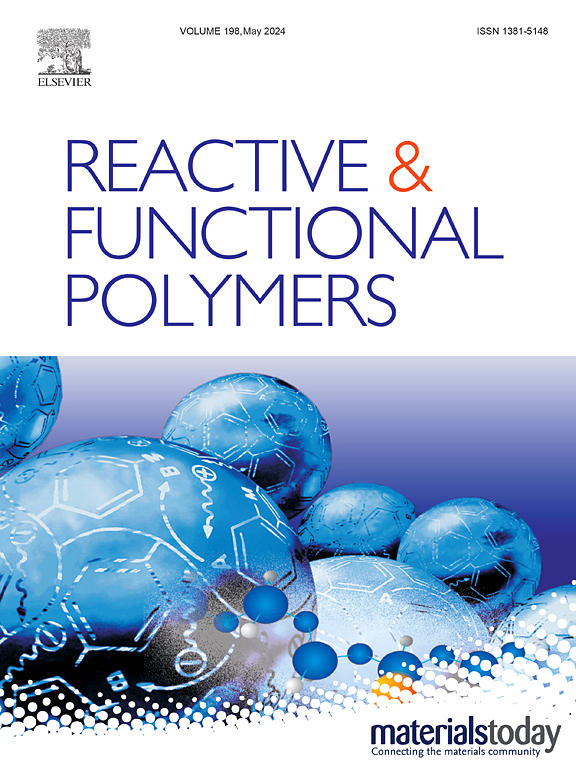高性能热塑性聚酰亚胺由酮基二胺单体启用
IF 4.5
3区 工程技术
Q1 CHEMISTRY, APPLIED
引用次数: 0
摘要
热塑性聚酰亚胺(TPI)作为胶粘剂可以满足柔性覆铜层压板(fccl)在极端条件下的应用要求。在主链中加入柔性基团、不对称结构和庞大的侧基以及共聚是实现热塑性的常用方法,通过降低聚合物链的刚性或分子间相互作用。然而,它引起了热塑性和热尺寸稳定性以及机械性能之间的权衡。此外,在FCCL中,TPI薄膜与铜箔之间的粘附强度是非常理想的。在此,我们开发了酮基二胺1,3-苯基双((3 ' -氨基-[1,1 ' -联苯]-4-基)甲烷)(Ph-BiAmMe),与4,4 ' -氧二胺(ODA)和3,3 ',4,4 ' -联苯四羧基二酐(BPDA)共聚TPI。在热塑性方面,醚、酮等柔性键增强了聚合物链的可动性,共聚在一定程度上削弱了聚合物链之间的分子间相互作用。此外,Ph-BiAmMe的加入促进了更致密的链填充和更强的CTC效应,从而保持了良好的热尺寸稳定性和力学性能。同时,酮基与铜结合可提高TPI的剥离强度。基于该策略,制备的TPI具有良好的热塑性,Tg为274℃。同时,该材料具有低CTE (46.5 ppm K−1)、高抗拉强度(117.4 MPa)、断裂伸长率(27.3%)和剥离强度(1.11 N mm−1)。本文章由计算机程序翻译,如有差异,请以英文原文为准。

High-performance thermoplastic polyimide enabled by ketone-based diamine monomer
Thermoplastic polyimide (TPI) as adhesive can meet the requirements of flexible copper clad laminates (FCCLs) applied under extreme condition. Incorporating flexible groups, asymmetric structures and bulky side groups into the main chain, and copolymerization are common ways to achieve thermoplasticity, through reducing the rigidity of polymer chains or intermolecular interaction. However, it induces a trade-off between thermoplasticity and thermal dimensional stability as well as mechanical property. Furthermore, the adhesion strength between TPI film and copper foil is highly desirable in FCCL. Herein, we develop a ketone-based diamine 1,3-phenylenebis((3′-amino-[1,1′-biphenyl]-4-yl)methanone) (Ph-BiAmMe) to afford copolymerized TPI with 4,4′-oxydianiline (ODA) and 3,3′,4,4’-Biphenyltetracarboxylic dianhydride (BPDA). As for thermoplasticity, flexible linkages such as ether and ketone enhance the movability of polymer chains, and copolymerization weakens the intermolecular interaction between polymer chains to some extent. Furthermore, the incorporation of Ph-BiAmMe promotes denser chain packing and stronger CTC effect, thereby maintaining good thermal dimensional stability and mechanical properties. Simultaneously, ketone moieties enhance the peel strength of TPI when bonded with copper. Based on this strategy, the as-prepared TPI shows good thermoplasticity with a proper Tg of 274 °C. Meanwhile, it preserves a low CTE of 46.5 ppm K−1, high tensile strength of 117.4 MPa, elongation at break of 27.3 % and peel strength of 1.11 N mm−1.
求助全文
通过发布文献求助,成功后即可免费获取论文全文。
去求助
来源期刊

Reactive & Functional Polymers
工程技术-高分子科学
CiteScore
8.90
自引率
5.90%
发文量
259
审稿时长
27 days
期刊介绍:
Reactive & Functional Polymers provides a forum to disseminate original ideas, concepts and developments in the science and technology of polymers with functional groups, which impart specific chemical reactivity or physical, chemical, structural, biological, and pharmacological functionality. The scope covers organic polymers, acting for instance as reagents, catalysts, templates, ion-exchangers, selective sorbents, chelating or antimicrobial agents, drug carriers, sensors, membranes, and hydrogels. This also includes reactive cross-linkable prepolymers and high-performance thermosetting polymers, natural or degradable polymers, conducting polymers, and porous polymers.
Original research articles must contain thorough molecular and material characterization data on synthesis of the above polymers in combination with their applications. Applications include but are not limited to catalysis, water or effluent treatment, separations and recovery, electronics and information storage, energy conversion, encapsulation, or adhesion.
 求助内容:
求助内容: 应助结果提醒方式:
应助结果提醒方式:


